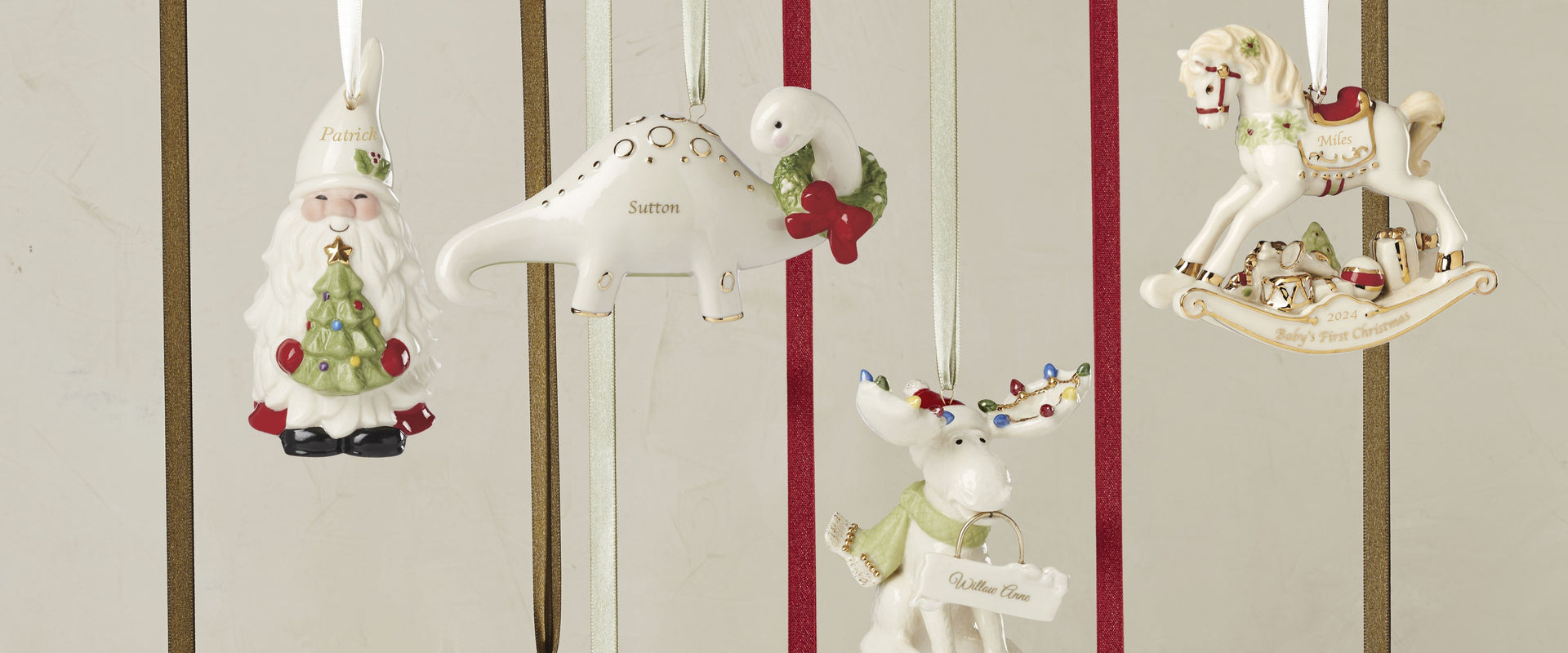
Every December, households around the globe embrace the age-old tradition of decorating the Christmas tree. As you unwrap each Christmas ornament, especially personalized ornaments and those vintage Christmas tree ornaments passed down from previous generations, it’s hard not to feel a surge of nostalgia.
Beloved brands like Lenox have been an integral part of many family celebrations, offering exquisite pieces that become instant heirlooms. Each decoration, every piece of Christmas decor—be it a glass bauble, a Lenox masterpiece, or a wooden Santa Claus—carries with it stories and memories from Christmases past. The history of Christmas ornaments is a rich tapestry, woven over centuries and across cultures. Let's embark on a festive journey to explore this vibrant history.
German Roots: The Authentic Origins of Christmas Ornaments
The dense forests of Germany, where evergreen trees reach for the sky, are where our story begins. In the 16th century, the concept of a Christmas tree was deeply rooted in German tradition. Families would venture into the crisp winter air to choose the perfect fir tree. Once inside, it was adorned with apples, nuts, and other treats. These “Paradise Trees” weren't just for decoration but carried religious significance, symbolizing the fruits of Eden.
German artisans, recognizing the potential for more permanent decorations, began crafting exquisite ornaments. Hans Greiner, one of the notable artisans of the time, led the way in producing captivating glass Christmas ornaments. These glass ornaments, often reflecting the light of candles, became centerpieces of Christmas Eve celebrations.
When Prince Albert of Germany married Queen Victoria, he brought this delightful tradition to England. A drawing of the royal family celebrating around a decorated tree in Windsor Castle made its way to New York. Before long, Americans were emulating this European tradition, giving a festive touch to their homes during the holiday season.
From Apples to Blown Glass: The Evolution of Holiday Decorations
The journey of Christmas decorations is a tale of innovation and creativity. In the early days, Christmas tree decorations were organic and simple. Families decorated with what they had, which often meant paper roses, candies, and the warm glow of lit candles. It was all about the significance rather than the spectacle.
But as time flowed like the molten glass in Lauscha, Germany, the very nature of ornaments began to change. Glassblowers, with their unmatched skill, started molding glass into fruits, nuts, and figures like Santa Claus and St Nicholas. These glass Christmas ornaments, with their intricate designs and vibrant colors, soon captivated the rest of the world.
The allure of these decorations caught the attention of American entrepreneur F.W. Woolworth, who recognized their commercial potential. By the end of the 19th century, Woolworth was selling a staggering amount of these imported ornaments, leading to a holiday decoration boom in the United States.
Worldwide Wonder: Cultural Significance of Christmas Ornaments
As the Christmas tree tradition spread, countries infused it with their local cultures and stories. Each nation added its unique touch, reflecting its history and values.
In Ukraine, for example, you'd often find a tree adorned with a spider and its web, a symbol of good luck and prosperity. Travel to Australia, and your Christmas tree might have a kangaroo ornament, capturing the essence of the land down under. Hosting a New Year's Eve party at home in Russia? Don’t be surprised to find ornaments shaped like pickles, nodding to the old German legend of the Christmas pickle.
A Modern Twist: The Rise of Personalized and DIY Ornaments
While the essence of Christmas Eve remains timeless, the style and nature of ornaments have seen a whirlwind of change. Today's Christmas ornaments range from hand-crafted vintage ornaments that take one down memory lane to DIY ornaments that add a personal touch and even to high-tech ornaments that light up and play music.
Personalization is the buzzword now. Ornaments often capture life's milestones—a wedding anniversary, a baby's first Christmas, or even a graduation. And if you're keen to add a sprinkle of global charm to your tree, ornaments inspired by traditions from around the world are becoming increasingly popular. From Japanese origami decorations to African beadwork, there's an ornament to reflect every culture and story.
Iconic Ornaments Through the Decades
As Christmas ornaments journeyed through time, certain eras saw the birth of iconic designs that have since become symbolic of the time they originated. These designs, driven by the cultural, economic, or artistic movements of the period, offer a fascinating glimpse into the changing aesthetics and sensibilities of societies over the years.
Roaring Twenties
The 1920s, known for its jazz, flapper dresses, and a certain carefree decadence, birthed Christmas tree ornaments that echoed the era's opulence. Think glittering ornaments, intricate patterns, and radiant colors like silver and gold—a mirror to the era's exuberance.
War-Torn Thirties and Forties
The '30s and '40s were marked by global conflict and economic depression. The ornaments from this time showcased resilience and simplicity. Many families crafted their own ornaments using paper, fabric, or reused materials, turning to creativity in the face of adversity.
Swinging Sixties
This decade was all about breaking the mold and embracing vibrant colors, psychedelic patterns, and novelty designs. Christmas ornaments weren’t spared from this whimsical touch, with many trees featuring unconventional shapes and space-age designs, a nod to the race to the moon.
Eco-Conscious 2000s
As the new millennium dawned and environmental concerns took center stage, many chose sustainable and eco-friendly materials for their ornaments. Handcrafted pieces, made from recycled or natural materials, became popular as a response to increasing concerns about consumerism and its environmental footprint.
The Digital Age
Today, as technology dominates our lives, it's no surprise to find ornaments that reflect this. From ornaments shaped like popular emojis to those incorporating LED lights, to those that play your favorite carols or even display family photos digitally, the modern tree showcases our ever-evolving digital landscape. And with events like the COVID-19 pandemic shaping our history, it comes as no surprise that one of the most popular Christmas ornaments recently has been a tiny roll of toilet paper, a humorous ode to the frequent shortage of the product.
Looking back at these iconic ornaments is like taking a walk down memory lane. Each decade, with its unique challenges and triumphs, has left an indelible mark on how we celebrate and decorate. As we await what the next decade will bring to our festive trees, one thing remains clear: antique Christmas ornaments are not just decorations; they're historical artifacts, capturing the spirit of the times.
A Time-Honored Tradition with a Dash of Modernity
From simple apples on German evergreen trees to the eclectic mix of ornaments found on today’s Christmas trees, these festive decorations have been silent witnesses to history. They've seen wars and peace, economic booms and busts, and technological revolutions. Yet, their core purpose remains unchanged: to bring joy, unity, and festivity into our homes.
So, this Christmas Day, as you decorate your tree, take a moment. Realize that with each ornament you hang—new and old–-you're not just decorating; you're commemorating centuries of tradition, celebration, and stories.
And speaking of stories, the tale doesn't end here. Every year brings with it new designs, new materials, and new stories. So, here's to creating more memories, to passing down more ornaments, and to a future where every Christmas tree tells a unique, timeless tale.
Feeling inspired? Unwrap Lenox's rich collection of Christmas decor and Christmas ornament sets, add another chapter to your Christmas story.
Merry Christmas! Whether you’re decking your halls with family heirlooms or looking for holiday tablescape ideas to start a new tradition, may your festive season be filled with joy, stories, and memories that last a lifetime.
Sources:
Brown, LeAnna. “Hand Blown Glass Christmas Ornaments from Germany: A Centuries Old Tradition.” WanderInGermany, 22 Dec. 2020, www.wanderingermany.com/hand-blown-glass-christmas-ornaments-from-germany/. Accessed 11 Sept. 2023.
Foussianes, Chloe. “You Can Thank Queen Victoria for Your Christmas Tree.” Town & Country, 18 Dec. 2018, www.townandcountrymag.com/society/tradition/a25619292/queen-victoria-prince-albert-christmas-tree-holiday-tradition/.
German-Way.com, 2022, www.german-way.com/history-and-culture/holidays-and-celebrations/christmas/glass-christmas-ornaments/.
Holtermann, Callie. “Christmas Trees Trimmed in Irony.” The New York Times, 27 Nov. 2022, www.nytimes.com/2022/11/27/style/christmas-ornaments.html.
November 1, Cheryl Fenton Updated, and 2021. “Silver and Gold Creates a Roaring ’20s Christmas Vibe—Here’s How to Get the Look.” Reviewed, reviewed.usatoday.com/christmas/features/silver-and-gold-creates-roaring-20s-christmas-look. Accessed 11 Sept. 2023.
Nurseries, Weston. “Christmas Ornaments: Origins, History and Meaning | Blog.” Weston Nurseries, 7 Dec. 2020, www.westonnurseries.com/christmas-ornaments-origins-history-and-meaning/. Accessed 11 Sept. 2023.
Schumer, Lizz. “The History of the Christmas Pickle, a Zany Holiday Tradition.” Good Housekeeping, 16 Nov. 2020, www.goodhousekeeping.com/holidays/christmas-ideas/a34646119/christmas-pickle-ornament-tradition/.
“The Ukrainian Tradition of Spider Webs and Christmas.” Ukraine.com, www.ukraine.com/blog/spiders-and-their-webs-are-not-showed-the-door-on-ukrainian-christmas/





